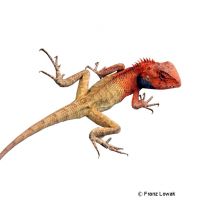Oriental Garden Lizard (Calotes versicolor)
| Oriental Garden Lizard Calotes versicolor | |
|---|---|
| Name | Oriental Garden Lizard |
| Name Lat. | Calotes versicolor |
| Family | Agamas |
| Family lat. | Agamidae |
| Order | Scaled Reptiles |
| Order lat. | Squamata |
| Origin | Southeast Asia |
| Habitat | Forests, shrubland |
| Diet | Insects |
| Humidity | 70-80 % |
| Behavior | ♂ territorial |
| Keeping | Individual, pair, harem |
| Care Level | Difficult |
| Reproduction | Oviparous |
| Housing | Humid terrarium |
| Life Span | 10 years |
| Protection | No |
| Metric Units | |
| Size | 40 cm |
| Temperature | 23-25 °C |
| Temperature Local | 30 °C |
| Housing Size | 100 x 80 x 100 cm |
| US Units | |
| Size | 16" |
| Temperature | 73-77 °F |
| Temperature Local | 86 °F |
| Housing Size | 40" x 30" x 40" |
Distribution and habitat
The diurnal, often tree-dwelling bloodsucker dragons are widespread in sparse forests and scrubland from Afghanistan, Pakistan and Sri Lanka to southern China and Sumatra. As crop followers, they are also frequently found in settlements, gardens and cultivated land.
Maintenance
Minimum dimensions for the terrarium, according to the size and number of animals
| 1-2 animals | 5KRL x 4KRL x 5KRL (L x W x H) |
Head-torso length (KRL) is measured on the largest animal. For each additional animal, increase the footprint by 15%. Ideal is a terrarium of e.g. L 100 x W 80 x H 100 cm, which should be placed in a quiet and vibration-free place
You need a humid terrarium with strong, vertical and horizontal climbing branches, structured back and side walls (e.g. cork covering), a substrate of forest soil-peat mixture as well as many plants (ficus, ferns, mosses, epiphytes etc.). In addition, a large water section (about 5 cm deep) with a clean, moving water for drinking and bathing. Several times a day the inside of the terrarium should be finely sprayed with water (humidity), but a rain or mist system is better
| Temp. day: 23-25 °C | Temp. night: 20-23 °C | Temp. local: up to 30 °C | Humidity: 70-80 |
The lighting duration must be 12-14 hrs. Special lamps with high UV-A and UV-B content are ideal, because daily UV irradiation is essential.
Diet
The diet consists of live insects, such as crickets, house crickets, grasshoppers, earthworms, centipedes, zophobas larvae, and pieces of meat and fish or small fish. Alternatively, special ready-made food for insectivores can be offered. Wax moths should rarely be fed in very small amounts because of their large fat content. Regular addition of minerals and vitamins (dusting of food) is important. Young animals should be offered food daily, adults 4-5 times a week. Drinking water must always be available, but is preferably taken in drop form from leaves or furnishings
A regular and varied diet promotes health and prevents deficiency symptoms.
Reproduction and breeding
The adult male has a thickened caudal root with a distinct hemipenis pouch.
The female buries her eggs (10-30 pieces) in the substrate, which must accordingly consist of a substrate suitable for burrowing. The incubation period is 40-50 days at a temperature of 30 °C. Small insects such as fruit flies and micro crickets are suitable as initial food for the young.
The life expectancy can be 10 years
Important
Adult males behave territorially and there may be incompatibilities among themselves. Striking is the color change of the males, which get a dark red head during courtship or territory defense. For the well-being of the animals moving water (e.g. watercourses, waterfalls) should be absolutely present. Besides sunny places, shady, cooler places are also necessary
With fruit and honey water as food for the feeders, their quality can be upgraded.
The terrarium must have good ventilation without drafts and meet the species specific needs. Measuring devices such as thermometers, hygrometers, etc. are necessary. The lighting has to correspond to the species-specific day-night rhythm and has to be placed in such a way that the animals cannot injure themselves. The terrarium should be locked in such a way that neither unauthorized persons can open it nor the animals can escape. Contamination must be removed regularly
Further literature can be found in your pet store.
References
Text: Christian Sänger; Image: Franz Lowak
Source: BMELV (1997): Mindestanforderungen an die Haltung von Reptilien; ENGELMANN (2006): Zootierhaltung - Tiere in menschlicher Obhut: Reptilien und Amphibien, Harri Deutsch Verlag
- Gemäß § 21 Abs. 5 Tierschutzgesetz idgF
